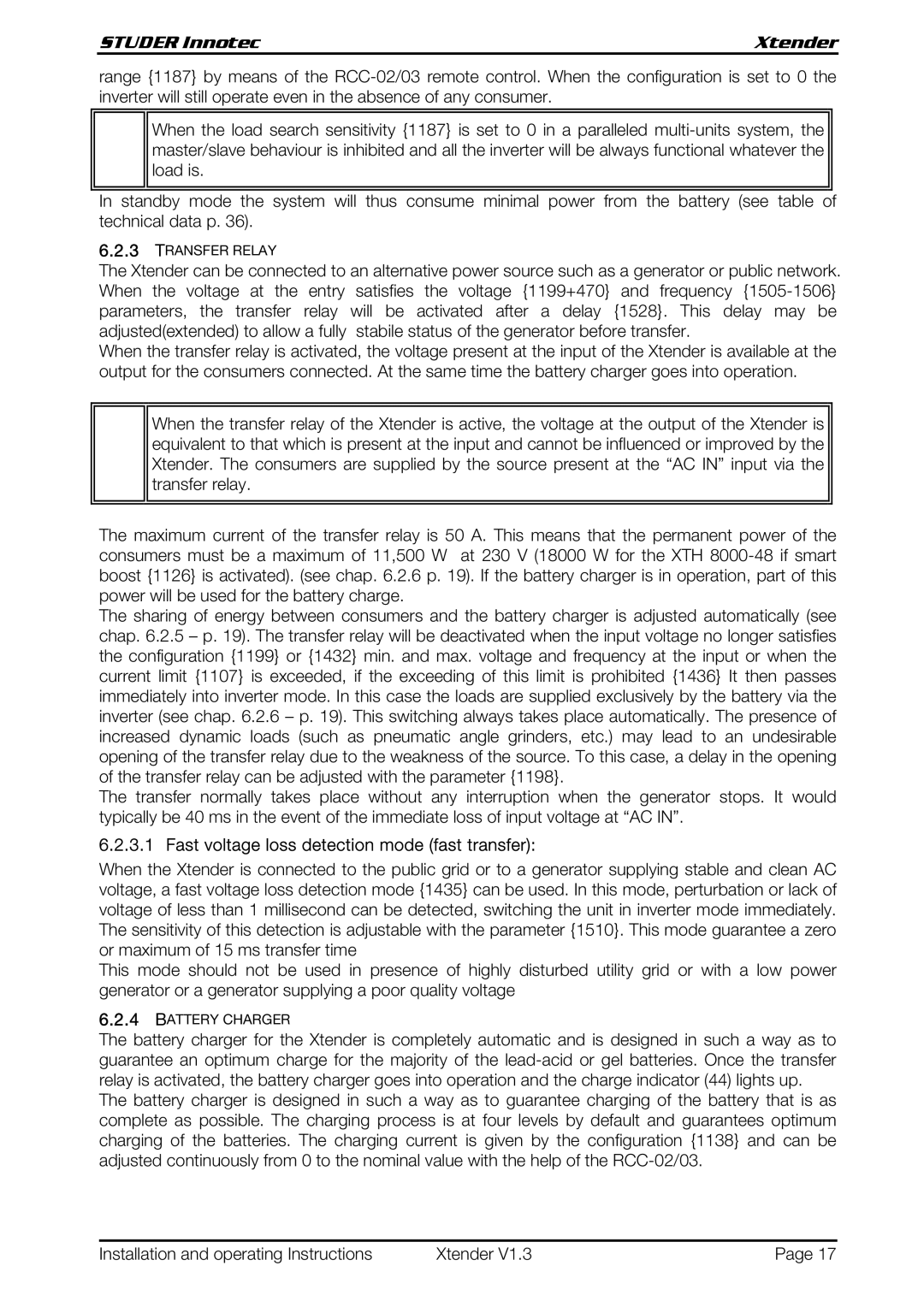
STUDER Innotec | Xtender |
range {1187} by means of the
When the load search sensitivity {1187} is set to 0 in a paralleled
In standby mode the system will thus consume minimal power from the battery (see table of technical data p. 36).
6.2.3TRANSFER RELAY
The Xtender can be connected to an alternative power source such as a generator or public network. When the voltage at the entry satisfies the voltage {1199+470} and frequency
When the transfer relay is activated, the voltage present at the input of the Xtender is available at the output for the consumers connected. At the same time the battery charger goes into operation.
When the transfer relay of the Xtender is active, the voltage at the output of the Xtender is equivalent to that which is present at the input and cannot be influenced or improved by the Xtender. The consumers are supplied by the source present at the “AC IN” input via the transfer relay.
The maximum current of the transfer relay is 50 A. This means that the permanent power of the consumers must be a maximum of 11,500 W at 230 V (18000 W for the XTH
The sharing of energy between consumers and the battery charger is adjusted automatically (see chap. 6.2.5 – p. 19). The transfer relay will be deactivated when the input voltage no longer satisfies the configuration {1199} or {1432} min. and max. voltage and frequency at the input or when the current limit {1107} is exceeded, if the exceeding of this limit is prohibited {1436} It then passes immediately into inverter mode. In this case the loads are supplied exclusively by the battery via the inverter (see chap. 6.2.6 – p. 19). This switching always takes place automatically. The presence of increased dynamic loads (such as pneumatic angle grinders, etc.) may lead to an undesirable opening of the transfer relay due to the weakness of the source. To this case, a delay in the opening of the transfer relay can be adjusted with the parameter {1198}.
The transfer normally takes place without any interruption when the generator stops. It would typically be 40 ms in the event of the immediate loss of input voltage at “AC IN”.
6.2.3.1 Fast voltage loss detection mode (fast transfer):
When the Xtender is connected to the public grid or to a generator supplying stable and clean AC voltage, a fast voltage loss detection mode {1435} can be used. In this mode, perturbation or lack of voltage of less than 1 millisecond can be detected, switching the unit in inverter mode immediately. The sensitivity of this detection is adjustable with the parameter {1510}. This mode guarantee a zero or maximum of 15 ms transfer time
This mode should not be used in presence of highly disturbed utility grid or with a low power generator or a generator supplying a poor quality voltage
6.2.4BATTERY CHARGER
The battery charger for the Xtender is completely automatic and is designed in such a way as to guarantee an optimum charge for the majority of the
The battery charger is designed in such a way as to guarantee charging of the battery that is as complete as possible. The charging process is at four levels by default and guarantees optimum charging of the batteries. The charging current is given by the configuration {1138} and can be adjusted continuously from 0 to the nominal value with the help of the
Installation and operating Instructions | Xtender V1.3 | Page 17 |
